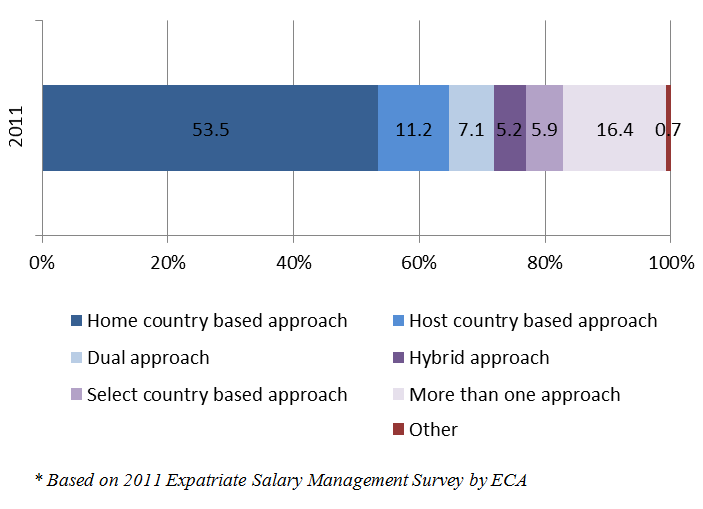Lately several of my blog posts related to expatriate compensation systems; hence I thought that giving an overview of the most recent survey results on international salary management is an appropriate closure to the topic.
At the end of 2011, ECA International finalized their biennial Expatriate Salary Management Survey, which features input from 269 multinational companies from around the world. The survey focuses on long-term international assignments with respect to their pay policies.
Concerning the implemented salary systems, respondents were first asked to give their three most important objectives for choosing their dominant approach to compensation. For the majority of companies (61%) the main objective was to ensure equity between all assignees. Thus, the perception of fairness and consistency of pay systems by assignees is an important factor. The second most cited objective (48%) was to guarantee equity with home country peers, which relates to the idea of maintaining the home country standard of living. The third most important reason (38%) was cited as facilitating expatriation and any onward move. Apart from these top three, the following objectives were also stated: motivating assignees to accept an assignment (33%), need for transparency (29%), equity with host country peers (23%), ease of administration (22%), matching international market rates (16%), and controlling costs (15%).
As for the type of the compensation approach chosen, the trend clearly shows that the home country based approach (or balance sheet approach) continues to be the most popular. This result is not surprising in terms of supporting the main salary system objectives cited before. The overall distribution of the applied compensation approaches is shown in the following figure.
Figure 1. Types of International Assignment Salary Systems (%)
It is interesting to note that 16% of the companies choose to apply more than one approach outlined above. Moreover, this type of compensation has increased compared to 2001 (11%), and the survey authors anticipate this gradual trend towards using multiple approaches to continue. When applying more than one approach, the choice usually depends on the combination of the assignee’s home and host countries and the assignment purpose. Thus, the choice may be tailored for each assignee. For example, a home country based approach might be used for assignees moving from developed to developing countries whereas the host country approach could be used for transfers in the opposite direction.
Finally, the survey addressed the question of flexibility of the applied policies and the changes that are planned or already undertaken. The results indicate that 52% of respondents allow for a degree of flexibility to their policies. The main variations include applying more than one compensation approach and modifying some aspects of the policy in accordance to the level of seniority or the degree of mobility required. Apart from being flexible, the companies seem to be more active in introducing changes to their policies compared to previous years. About 40% of the respondents reported making changes within the last three years, and 31% are planning to make changes within the next three years. Generally speaking, the changes embrace a very wide variety of topics, which range from some radical changes (e.g. shifting from a home-based to a host-country approach) to smaller tactical and administrative modifications to different elements of compensation (e.g. reduction of home allowance benefits). Related to this point, the survey authors conclude, that ‘overall, the world of expatriate pay continues in a state of flux. There is no clear trend towards either reducing allowances and/or benefits or increasing them.’


